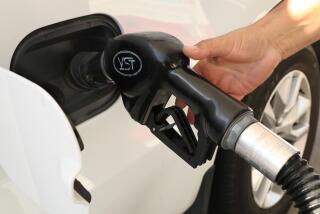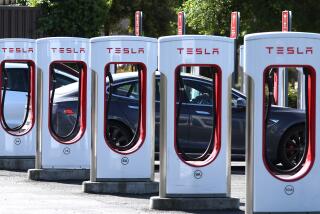‘Cash for clunkers’ final tally: 700,000 cars sold
- Share via
WASHINGTON AND LOS ANGELES — Government officials declared the “cash for clunkers” program a winner as they released final data Wednesday showing the program sparked the sale of nearly 700,000 new vehicles, boosting a devastated industry and the struggling economy.
But the coming weeks will show whether the program was a bargain or a lemon.
Dealers still were awaiting millions of dollars in payments. Analysts wondered whether the program generated actual new sales or simply lured buyers to act sooner. Prices for some popular vehicles apparently went up. And some people enticed by the $3,500 and $4,500 rebates now worry they might have overextended themselves in taking the plunge to put a new car in the driveway during a recession.
Auto research firm Edmunds.com predicted Wednesday that the industry “is likely to experience a painful hangover” after the monthlong cash-for-clunkers party.
“People rushed into purchases that many would otherwise have made later this year. The result will be lower sales in the weeks to come,” said Edmunds Chief Executive Jeremy Anwyl.
The number of people who intend to buy a new car in the next two months was down 50% from the peak of the clunkers program and 11% from the average in June, the firm said.
The frenzy generated by the program might have prevented some buyers from striking the best deal. Preliminary data gathered by TrueCar, a website that tracks auto pricing, indicated that dealers were charging higher prices and reaping bigger profits on some vehicles favored by cash-for-clunkers shoppers.
For example, dealer profit margins on the Chevrolet Aveo jumped to 4.9% in the first week of August from 1.8% in early July, according to TrueCar data.
“We’ve received reports from dealers that the markup on most qualified vehicles got progressively higher as we got closer to the end of the program,” said Jesse Toprak, the site’s vice president of industry trends.
The National Automobile Dealers Assn. questioned the data.
“Dealers have seen a very dry spell before cash for clunkers, and I don’t see them wildly inflating prices,” said spokesman Bailey Wood.
Still, the report could add to the buyer’s remorse some participants are feeling.
CNW Marketing Research Inc., which tracks consumer buying habits, said a survey of 1,000 cash-for-clunkers participants found that 17% had doubts about their purchase of a new car, primarily because of the $275-to-$350 monthly payment they’re now facing. The typical level of car buyer remorse is about 6% to 8%, and it goes up a few percentage points when incentives are offered, said Art Spinella, the company’s president.
Noting that hurried buyers may have felt pressured to take whatever offer was on the table rather than to bargain for a better deal, Edmunds.com senior analyst Jessica Caldwell said, “I think some people felt that time was of the essence and they had to buy very fast.”
At a time when dealers have been scrambling just to get customers on their lots, such experiences could hurt them down the road, she added.
“A lot of consumers have been scarred by this experience, and they’ll have even more dread the next time they buy a new car,” Caldwell said.
But Transportation Secretary Ray LaHood stressed the positive as he released the $3-billion program’s final numbers.
“This is one of the best economic news stories we’ve seen, and I’m proud we were able to give consumers a helping hand,” he said. The Transportation Department touted a White House estimate that cash for clunkers would increase domestic economic growth 0.3% to 0.4% in the third quarter and would create or save 42,000 jobs in the second half of the year.
Sales to consumers ended Monday evening, but because of technical glitches in the government’s online filing system, dealers were given an additional 24 hours to submit the complex applications for payment. Dealers submitted 690,114 applications for rebates totaling nearly $2.9 billion through Tuesday’s deadline, the department said.
The program, which offered rebates to motorists who traded in gas guzzlers for more fuel-efficient new cars, proved wildly popular. It burned through its initial $1-billion allotment in about a week late last month, causing Congress to quickly authorize an additional $2 billion.
Obama administration officials had hoped the money would keep the program running through Labor Day. But concerns that cash for clunkers would go over its budget led LaHood to announce last week that it would end Monday. Dealers could not be reimbursed for rebates once the program reached its $3-billion limit.
Figures released Wednesday showed that California auto dealers requested the most in reimbursements, $326.8 million, followed by those in Texas, New York and Illinois.
Timely payment to dealers, some of whom are owed more than $3 million, will be a key measure of the program’s effectiveness, industry spokesman Wood said.
“Did it get thousands of gas guzzlers off the road? Yes. Did it stimulate auto sales? Yes,” he said. “But ultimately if dealers are left holding the bag . . . there are questions about how successful the program was.”
The Transportation Department did not have figures on how much money had been sent to dealers but said its staff was augmenting a team of more than 2,000 people processing dealer applications.
The average fuel efficiency of new vehicles purchased was 24.9 miles per gallon, an increase of 58% over the average mileage of the vehicles traded in.
The top three new vehicles bought through the program, and eight of the top 10, were from foreign-headquartered manufacturers, led by the Toyota Corolla. The best-selling U.S.-branded car, the Ford Focus, came in fourth, and the Ford Escape was 10th. Toyota vehicles accounted for 19.4% of the new-vehicle sales, followed by General Motors with 17.6%, Ford with 14.4% and Honda with 13%.
One clear winner was South Korean automaker Hyundai, which accounted for 7.2% of clunker transactions -- far above its 4.3% overall U.S. market share through July. And that could help future sales.
“We are working very hard to hold on to our market share increases,” Hyundai spokesman Chris Hosford said.
Hyundai was helped by the fact that 13 of its 16 models qualified for the program and that it has some of the lowest car prices, which provided the opportunity for rock-bottom deals once the government rebates were factored in.
--







